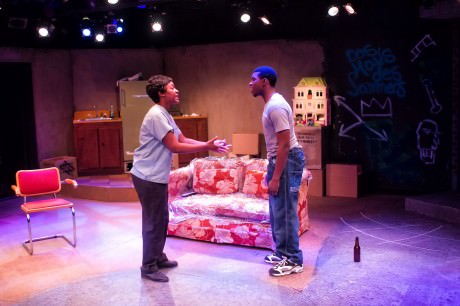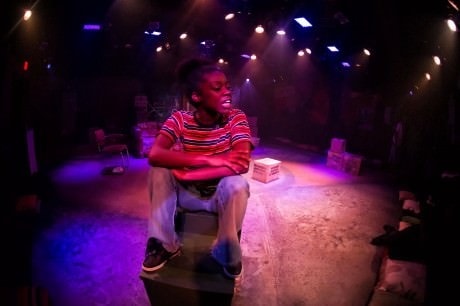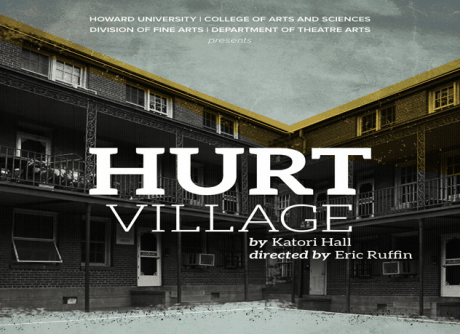The tension rises before the lights in this riveting production of Hurt Village by Katori Hall and powerfully directed by Eric Ruffin. Howard University has always been respected for their dynamite theater department; Hurt Village displays its potency.

Cookie (Birgundi Baker), begins her raw, angry rap in the dark. As the lights come up, all of the members of the ensemble join to raise the rap and accompanying rhythm to tremendous heights. This is no ordinary, rap slam on the street corner. Cookie’s rap embodies the hopes, fears, frustrations and much too early insights of Cookie and the ensemble as a whole. For Cookie is but 13 years-old, a whiz-kid and member of an extended family living in a soon-to-be demolished project in Memphis.
Each ensemble member fully inhabits their character. I have compliments for each performer. For me, the standout was Big Mama (Stephanie Desiree Pounds), overseer of her grandson’s girlfriend, Crank (Briana Lott) and Cookie. Others in the neighborhood rely on her also, especially Toyia (Mari’yam Floyd), Crank’s frenemy, and her sometimes boyfriend, Cornbread (Neko Ramos).

Big Mama’s strength, and hope, hold the action together throughout the play. Her monologues, of which there were several, were strong, poignant, and showed many facets of her life. Most poignant was her appeal to an unseen social worker to be allowed to bring her family into Section 8 housing, even though she worked as a cleaning woman in a VA hospital and made $347 over the poverty level required. It brought tears to my eyes.
It is ironic that Big Mama works at the VA as her grandson, Buggy (Earl Moore), recipient of a dishonorable discharge from the army while serving in Iraq, could not get any benefits or medical care from the VA. Buggy, Cookies father, tried, without success to win his way back into Cookie’s heart after his ten year absence while in the military. He was unsuccessful in his attempts which deepened his despair. During his absence, Cornbread was the most important male in Cookie’s life. Moore, as Buggy, gave a tremendously gripping exploration of the effects of untreated PTSD.
Tony C (Henian Boone) was the area’s drug supplier. His swagger, language, bling and dialogue fit the role with flair. Kudos to Costume Designer Reggie Ray for all of his work.
A fight between Tony C and Buggy in the second act was frightening in its raw anger and realism. I was afraid for Tony C’s life. What a great job by Joe Isenberg, the fight choreographer. Hurt Village’s gut-renching strength and strong message is boosted by choreography by Ana’z Cotton and Sound Design by TW Starnes.
Present throughout the evening were sidekicks Ebony (Sideeq Heard), “the smart one,” and Skillet (Martece Caudle), “the dumb one.” The way they played off of each other was a delight. Ebony’s sharp moves, joking raps and bright affect were in stark contrast with most of the other characters. Particularly impressive was Caudle’s portrayal of “the dumb one.” He didn’t overplay the “dumb.” In the second act, he provides Cookie with the most lucid and relevant advice. The perfect pitch with which Caudle played Skillet may have come from this sophomore’s already extensive TV experience.
Every member of the ensemble showed tremendous talent and will, I predict, become shining stars in their own right.

Particularly effective was the creative team’s use of the space and lighting. When center stage went dark, it was often accompanied by the eerily lit members of the ensemble coming onstage from the corners singing a nursery rhyme such as “Ring Around the Rosie” or “The Itsy Bitsy Spider”, sometimes with their common endings and, at appropriate times, much more catastrophic ones. This is but one example of George Epting’s effective lighting design and the overall excellence of the staging.
Especially in these hard economic times, Hurt Village addresses the hopes, dreams, and disappointments of a lot of Americans. If for no other reason, it shows the real effects on the citizens of a grinding government beurocracy. Howard University’s superb production deserves sold out houses. I encourage you to be an audience member.
Running Time: 2 hours and 30 minutes, including a 10-minute intermission.
Hurt Village plays through October 19, 2013 at Howard University’s Environmental Theater Space – 2455 6th Street, NW, in Washington, DC. For tickets, call the box office (202) 806-7700, or purchase them online.





